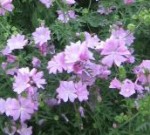 Musk mallow is a short-lived herbaceous perennial native to Europe, southwestern Asia, and northwestern Africa where it is found growing on dry fertile soils. It has naturalized elsewhere and grows along roadsides in North America. A relative of hibiscus, musk mallow belongs to the mallow family, Malvaceae, that also includes cotton, okra, and cacao. The bushy plant has numerous stout stems that are hairy and well branched. The lower leaves are up to six inches long, hairy and palmately lobed while upper leaves are deeply divided with five to seven segments. The saucer-shaped flowers are 2-2 ½ inches wide and have satiny petals that are wedge-shaped, notched, and rosy pink. They appear singly or in clusters in upper leaf axils over a long bloom time from early summer to early fall. Both flowers and foliage are musk-scented. Plants do best in cool climates and often self-seed. The genus name, Malva, is the Latin name for the flower; the specific epithet, moschata, comes from the Latin word meaning musky.
Musk mallow is a short-lived herbaceous perennial native to Europe, southwestern Asia, and northwestern Africa where it is found growing on dry fertile soils. It has naturalized elsewhere and grows along roadsides in North America. A relative of hibiscus, musk mallow belongs to the mallow family, Malvaceae, that also includes cotton, okra, and cacao. The bushy plant has numerous stout stems that are hairy and well branched. The lower leaves are up to six inches long, hairy and palmately lobed while upper leaves are deeply divided with five to seven segments. The saucer-shaped flowers are 2-2 ½ inches wide and have satiny petals that are wedge-shaped, notched, and rosy pink. They appear singly or in clusters in upper leaf axils over a long bloom time from early summer to early fall. Both flowers and foliage are musk-scented. Plants do best in cool climates and often self-seed. The genus name, Malva, is the Latin name for the flower; the specific epithet, moschata, comes from the Latin word meaning musky.
Type: Short-lived herbaceous perennial
Bloom: Rose pink, saucer-shaped flowers from early summer to early fall
Size: 2-3’ H x 2’ W
Light: Full sun
Soil: Average, medium moist, well-drained
Hardiness: Zones 3-8
Care: Deadhead for continuous bloom
Pests and Diseases: Japanese beetles
Propagation: Tip cuttings in early summer; seed indoors in late winter or outdoors in spring or fall
Companion plants: Artemesias, Coreopsis, Delphinium, Dianthus caesius, Dianthus plumarius, Liatris, old garden roses lox paniculata, Stachys byzantina, Veronica, yarrows
Outstanding Selections:
‘Alba’ (white flowers)
‘Rosa’ (dark pink flowers)